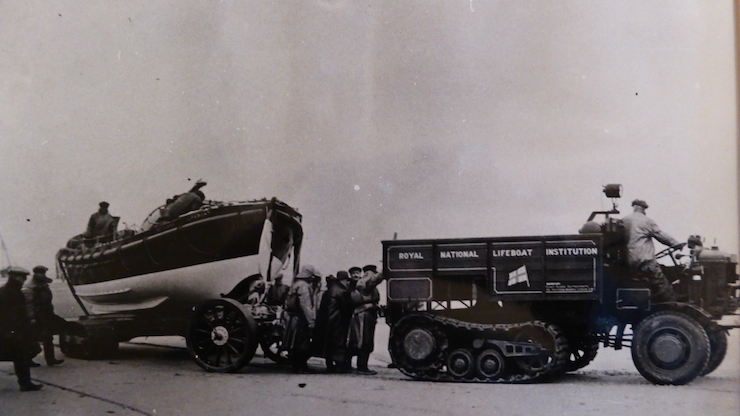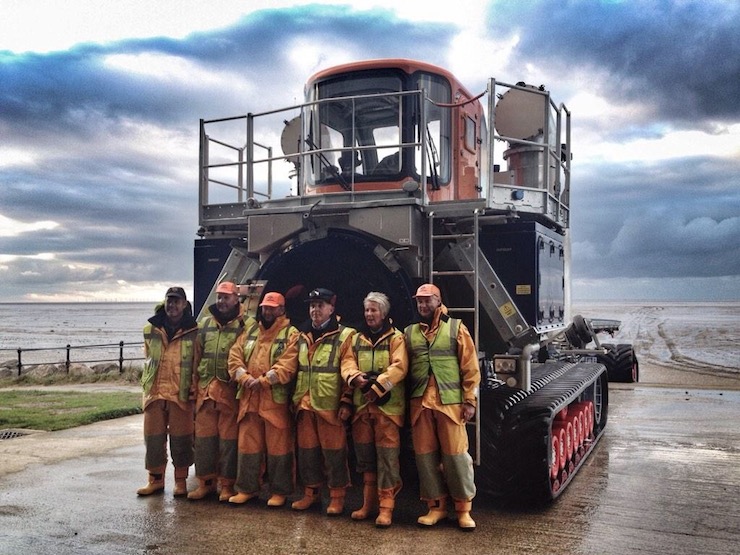I received a press release from RNLI this week (below) with the latest news about the training the crew are undertaking for the soon-to-arrive new lifeboat at Hoylake.
The photo above capturing a launch by horses of a lifeboat in 1920 is a world away from the mechanical horse power that the new Supacat tractor (pictured, bottom) offers. However, the crew of 1938 (pictured below) had progressed from horses to a tractor…
Here’s some of the current crew in front of the brand new Supacat tractor:
Here’s the RNLI press release that details all that’s currently happening at Hoylake RNLI:
The volunteer crew of Hoylake’s RNLI lifeboat are training hard in preparation for the arrival of the station’s revolutionary new Shannon class lifeboat. The new boat is due on station at the beginning of December and the crew are now undergoing intensive training with the purpose-built £1.2 million Launch and Recovery Vehicle which has already been delivered.
The new Shannon Launch and Recovery vehicle allows faster and more efficient launching and recovering of the lifeboat than the current Mersey class lifeboat system enabling volunteer crews to reach people in need even faster than before.
The bespoke system has been designed in conjunction with Supacat Ltd. It can operate in many different beach and sea conditions and allows a faster launch and recovery (10 minutes on average) compared with the Mersey system (25 minutes on average). This is achieved through minimising manual handling and utilising a turntable which rotates the Shannon ready for its next launch. It means that if a second call-out were to be received just after the boat has beached it could be back in the water much faster than the Mersey system.
The Launch and Recovery Vehicle now at Hoylake is to be named the Roland Hough after a local Hoylake businessman whose family made a generous donation to the charity to fund its provision. The Hoylake RNLI lifeboat must be capable of being launched at all states of the tide, this may mean that the boat may have to be towed well over one mile across the East Hoyle Sandbank to reach the tideline. In the early years of the Hoylake Station horses, owned by local contractors, pulled the old rowing and sailing lifeboats across the bank at little more than walking pace. The existing Talus tractor can pull the present Mersey class lifeboat at 7mph but the new Launch and Recovery vehicle will be able to tow the new lifeboat at 10 mph to its launch site.
Training for the Hoylake RNLI crew is being given by RNLI staff, many of whom are staying locally on Wirral until it is completed and the new boat is operational. A total of fifteen RNLI volunteers are attending crew training courses in using the new Launch and Recovery rig and lifeboat.
Mark Perry, the Lead Machinery Specialist, (Launch and Recovery) one of these trainers said ‘The training has been going really well. The lads and lasses on the crew are very keen to learn and very excited about the capabilities which the new Launching and Recovery System will bring to the Hoylake station. They have proved themselves a very efficient team in training. The future of the station is looking bright.’
Tracy Davies, one of the qualified Talus tractor drivers, said ‘The training has been very exciting and enjoyable. We feel very privileged to be allowed to use this state-of-the-art equipment. I know we all take the training very seriously as it is such a great responsibility but look forward confidently to operating the new Launch and Recovery Vehicle to save lives.’
Veteran lifeboatman and ex-Hoylake Coxswain, Dave Dodd MBE, the current Head Launcher, said ‘The new system is a huge step forward. The lifeboat Coxswain will be more in control of the launching. He or she will be able to release the boat from the Launch and Recovery Vehicle themselves, rather than relying on the coordination of the deck crew on the boat with the tractor and shore crew. In big surf on the bank this will be far faster and safer. There will be far fewer risks involved in recovering too, as there will be very little manual handling involved.’
Hoylake’s new Shannon RNLI lifeboat will be arriving at the Hoylake RNLI Station from the RNLI headquarters at Poole at the beginning of December. It is to be named Edmund Hawthorn Micklewood. This is thanks to the legacy of Paulette Micklewood, which has helped fund the state-of-the-art lifeboat.
The Shannon class is being rolled out to stations across the UK and Ireland. It is the RNLI’s next generation all-weather lifeboat (ALB) and is the most agile in the RNLI fleet. It is the first modern RNLI all-weather lifeboat to be propelled by water jets and not propellers. Capable of 25 knots the Shannon is 50% faster than the lifeboats it replaces – ensuring that those in need are reached even faster. The Shannon will replace both a selection of Mersey and Tyne class lifeboats, which are now nearing the end of their planned 25-year life span (the Mersey and Tyne have a lower maximum speed of 17 knots).



Comments